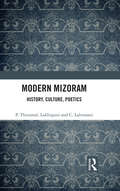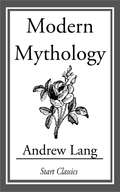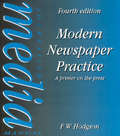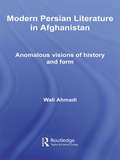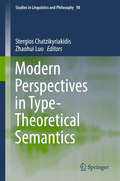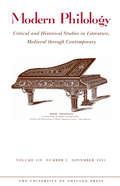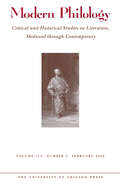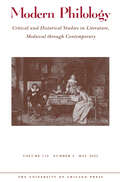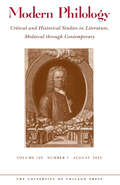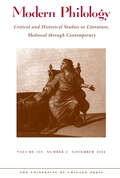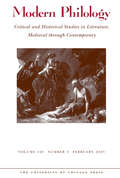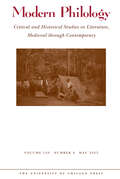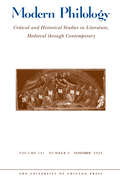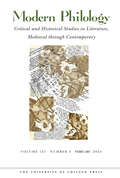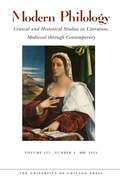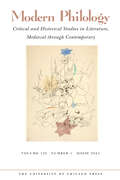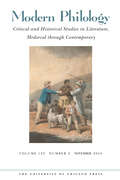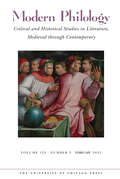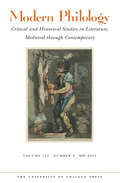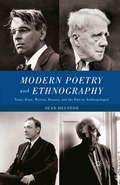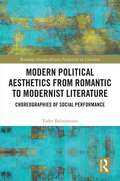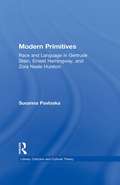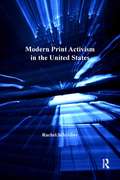- Table View
- List View
Modern Mizoram: History, Culture, Poetics
by P. Thirumal Laldinpuii C. LalrozamiMizoram is situated at a unique cusp in North East India, in terms of both physical and social contexts. It shares its borders with Myanmar and Bangladesh, while cultural influences range from the indigenous to the Western. This book offers an alternative understanding of the modern history of Mizoram through an analysis of its cultural practices through language, music, poetry and festivals. It explores the roots of modern cultural works not just in Christianity, but also in precolonial Mizo traditional practices. The authors closely examine text, performance and sculptural images, including the first handwritten newspaper Mizo Chanchin Laisuih (1898) and the Puma Zai festival (1907–11) from the early colonial period along with a contemporary sculptural image. They argue that cultural works open up to new forms of interpretations and responses over time. The book indicates that the Mizo creative sensibility enmeshed in theological, capitalistic-material and political/ideological regimes informs its modern enclosures, be it region, religion or nation. This book will be of great interest to scholars and researchers of cultural studies, literature, media, history, politics, sociology and social anthropology, area studies, North East India studies and South Asian studies.
Modern Mythology
by Andrew LangIt may well be doubted whether works of controversy serve any useful purpose. 'On an opponent,' as Mr. Matthew Arnold said, 'one never does make any impression,' though one may hope that controversy sometimes illuminates a topic in the eyes of impartial readers. The pages which follow cannot but seem wandering and desultory, for they are a reply to a book, Mr. Max Muller's Contributions to the Science of Mythology, in which the attack is of a skirmishing character. Throughout more than eight hundred pages the learned author keeps up an irregular fire at the ideas and methods of the anthropological school of mythologists. The reply must follow the lines of attack.
Modern Newspaper Practice: A primer on the press (Media Manuals Ser.)
by F W HodgsonAn introduction to all aspects of newspaper journalism and the journalist's world. The book examines in detail not only day-to-day practice but also the role of the editor and the reading public, and the running and printing of newspapers. Close attention in this new edition is paid to the effect of technological advance on news gathering, news and feature writing, page planning and design and the production, advertising and commercial side of newspapers. This book is widely used on journalism and media-related courses, including degrees and those run by newspaper companies and the NCTJ, and the many training schemes abroad that look at British practice.
Modern Persian Literature in Afghanistan: Anomalous Visions of History and Form (Iranian Studies)
by Wali AhmadiWith the unleashing of the "War on Terror" in the aftermath of 9/11, Afghanistan has become prominent in the news. However, we need to appreciate that no substantive understanding of contemporary history, politics and society of this country can be achieved without a thorough analysis of the Afghan encounter with cultural and literary modernity and modernization. Modern Persian Literature in Afghanistan does just that. The book offers a balanced and interdisciplinary analysis of the rich and admirable contemporary poetry and fiction of a land long tormented by wars and invasions. It sets out to demonstrate that, within the trajectory of the union between modern aesthetic imagination and politics, creativity and production, and representation and history, the modernist intervention enabled many contemporary poets and writers of fiction to resist the overt politicization of the literary field, without evading politics or disavowing the modern state. The interpretative moves and nuanced readings of a series of literary texts make this book a major contribution to a rather neglected area of research and study. Winner of the Iranian World Prize for Book of the Year in Islamics Studies 2009
Modern Perspectives in Type-Theoretical Semantics
by Stergios Chatzikyriakidis Zhaohui LuoThis book is a collective volume that reports the state of the art in the applications of type theory to linguistic semantics. The volume fills a 20 year gap from the last published book on the issue and aspires to bring researchers closer to cutting edge alternatives in formal semantics research. It consists of unpublished work by some key researchers on various issues related to the type theoretical study of formal semantics and further exemplifies the advantages of using modern type theoretical approaches to linguistic semantics. Themes that are covered include modern developments of type theories in formal semantics, foundational issues in linguistic semantics like anaphora, modality and plurals, innovational interdisciplinary research like the introduction of probability theory to type theories as well as computational implementations of type theoretical approaches. This volume will be of great interest to formal semanticists that are looking for alternative ways to study linguistic semantics, but will also be of interest to theoretical computer scientists and mathematicians that are interested in the applications of type theory.
Modern Philology, volume 119 number 2 (November 2021)
by Modern PhilologyThis is volume 119 issue 2 of Modern Philology. Modern Philology (MP) publishes original work in literary criticism, literary history, and archival scholarship. The journal welcomes contributions on literature in all modern world languages and encourages productive comparisons of texts and traditions from any part of the world. It accepts essays that focus on earlier periods as well as the present. MP also aims to publish timely review articles, reviews of recent books, and research on archival documents.
Modern Philology, volume 119 number 3 (February 2022)
by Modern PhilologyThis is volume 119 issue 3 of Modern Philology. Modern Philology (MP) publishes original work in literary criticism, literary history, and archival scholarship. The journal welcomes contributions on literature in all modern world languages and encourages productive comparisons of texts and traditions from any part of the world. It accepts essays that focus on earlier periods as well as the present. MP also aims to publish timely review articles, reviews of recent books, and research on archival documents.
Modern Philology, volume 119 number 4 (May 2022)
by Modern PhilologyThis is volume 119 issue 4 of Modern Philology. Modern Philology (MP) publishes original work in literary criticism, literary history, and archival scholarship. The journal welcomes contributions on literature in all modern world languages and encourages productive comparisons of texts and traditions from any part of the world. It accepts essays that focus on earlier periods as well as the present. MP also aims to publish timely review articles, reviews of recent books, and research on archival documents.
Modern Philology, volume 120 number 1 (August 2022)
by Modern PhilologyThis is volume 120 issue 1 of Modern Philology. Modern Philology (MP) publishes original work in literary criticism, literary history, and archival scholarship. The journal welcomes contributions on literature in all modern world languages and encourages productive comparisons of texts and traditions from any part of the world. It accepts essays that focus on earlier periods as well as the present. MP also aims to publish timely review articles, reviews of recent books, and research on archival documents.
Modern Philology, volume 120 number 2 (November 2022)
by Modern PhilologyThis is volume 120 issue 2 of Modern Philology. Modern Philology (MP) publishes original work in literary criticism, literary history, and archival scholarship. The journal welcomes contributions on literature in all modern world languages and encourages productive comparisons of texts and traditions from any part of the world. It accepts essays that focus on earlier periods as well as the present. MP also aims to publish timely review articles, reviews of recent books, and research on archival documents.
Modern Philology, volume 120 number 3 (February 2023)
by Modern PhilologyThis is volume 120 issue 3 of Modern Philology. Modern Philology (MP) publishes original work in literary criticism, literary history, and archival scholarship. The journal welcomes contributions on literature in all modern world languages and encourages productive comparisons of texts and traditions from any part of the world. It accepts essays that focus on earlier periods as well as the present. MP also aims to publish timely review articles, reviews of recent books, and research on archival documents.
Modern Philology, volume 120 number 4 (May 2023)
by Modern PhilologyThis is volume 120 issue 4 of Modern Philology. Modern Philology (MP) publishes original work in literary criticism, literary history, and archival scholarship. The journal welcomes contributions on literature in all modern world languages and encourages productive comparisons of texts and traditions from any part of the world. It accepts essays that focus on earlier periods as well as the present. MP also aims to publish timely review articles, reviews of recent books, and research on archival documents.
Modern Philology, volume 121 number 1 (August 2023)
by Modern PhilologyThis is volume 121 issue 1 of Modern Philology. Modern Philology (MP) publishes original work in literary criticism, literary history, and archival scholarship. The journal welcomes contributions on literature in all modern world languages and encourages productive comparisons of texts and traditions from any part of the world. It accepts essays that focus on earlier periods as well as the present. MP also aims to publish timely review articles, reviews of recent books, and research on archival documents.
Modern Philology, volume 121 number 2 (November 2023)
by Modern PhilologyThis is volume 121 issue 2 of Modern Philology. Modern Philology (MP) publishes original work in literary criticism, literary history, and archival scholarship. The journal welcomes contributions on literature in all modern world languages and encourages productive comparisons of texts and traditions from any part of the world. It accepts essays that focus on earlier periods as well as the present. MP also aims to publish timely review articles, reviews of recent books, and research on archival documents.
Modern Philology, volume 121 number 3 (February 2024)
by Modern PhilologyThis is volume 121 issue 3 of Modern Philology. Modern Philology (MP) publishes original work in literary criticism, literary history, and archival scholarship. The journal welcomes contributions on literature in all modern world languages and encourages productive comparisons of texts and traditions from any part of the world. It accepts essays that focus on earlier periods as well as the present. MP also aims to publish timely review articles, reviews of recent books, and research on archival documents.
Modern Philology, volume 121 number 4 (May 2024)
by Modern PhilologyThis is volume 121 issue 4 of Modern Philology. Modern Philology (MP) publishes original work in literary criticism, literary history, and archival scholarship. The journal welcomes contributions on literature in all modern world languages and encourages productive comparisons of texts and traditions from any part of the world. It accepts essays that focus on earlier periods as well as the present. MP also aims to publish timely review articles, reviews of recent books, and research on archival documents.
Modern Philology, volume 122 number 1 (August 2024)
by Modern PhilologyThis is volume 122 issue 1 of Modern Philology. Modern Philology (MP) publishes original work in literary criticism, literary history, and archival scholarship. The journal welcomes contributions on literature in all modern world languages and encourages productive comparisons of texts and traditions from any part of the world. It accepts essays that focus on earlier periods as well as the present. MP also aims to publish timely review articles, reviews of recent books, and research on archival documents.
Modern Philology, volume 122 number 2 (November 2024)
by Modern PhilologyThis is volume 122 issue 2 of Modern Philology. Modern Philology (MP) publishes original work in literary criticism, literary history, and archival scholarship. The journal welcomes contributions on literature in all modern world languages and encourages productive comparisons of texts and traditions from any part of the world. It accepts essays that focus on earlier periods as well as the present. MP also aims to publish timely review articles, reviews of recent books, and research on archival documents.
Modern Philology, volume 122 number 3 (February 2025)
by Modern PhilologyThis is volume 122 issue 3 of Modern Philology. Modern Philology (MP) publishes original work in literary criticism, literary history, and archival scholarship. The journal welcomes contributions on literature in all modern world languages and encourages productive comparisons of texts and traditions from any part of the world. It accepts essays that focus on earlier periods as well as the present. MP also aims to publish timely review articles, reviews of recent books, and research on archival documents.
Modern Philology, volume 122 number 4 (May 2025)
by Modern PhilologyThis is volume 122 issue 4 of Modern Philology. Modern Philology (MP) publishes original work in literary criticism, literary history, and archival scholarship. The journal welcomes contributions on literature in all modern world languages and encourages productive comparisons of texts and traditions from any part of the world. It accepts essays that focus on earlier periods as well as the present. MP also aims to publish timely review articles, reviews of recent books, and research on archival documents.
Modern Poetry and Ethnography
by Sean HeustonThis study maps a new approach to the works of W. B. Yeats, Robert Frost, Robert Penn Warren, and Seamus Heaney. Sean Heuston combines interdisciplinary analysis, specifically ethnography, with close reading, and in so doing argues provocatively for the intersection of modern poetry studies and contemporary ethnographic theory.
Modern Political Aesthetics from Romantic to Modernist Fiction: Choreographies of Social Performance (Routledge Interdisciplinary Perspectives On Literature Ser.)
by Tudor BalinisteanuIn this new research monograph, Tudor Balinsteanu draws on concepts of dance to demonstrate how the nonhuman is dealt with in terms of practical politics, that is, choreographies of social performance which emerge at the intersection of literature, art, and embodied life. Drawing on a number of influential texts by William Wordsworth, Joseph Conrad, W. B. Yeats, and James Joyce, this truly interdisciplinary monograph explores the relations between the human and the nonhuman across centuries of literature and as demonstrated in philosophical concepts and social experiments.
Modern Primitives: Race and Language in Gertrude Stein, Ernest Hemingway, and Zora Neale Hurston (Literary Criticism and Cultural Theory)
by Susanna PavloskaFirst Published in 2000. Routledge is an imprint of Taylor & Francis, an informa company.
Modern Print Activism in the United States
by Rachel SchreiberThe explosion of print culture that occurred in the United States at the turn of the twentieth century activated the widespread use of print media to promote social and political activism. Exploring this phenomenon, the essays in Modern Print Activism in the United States focus on specific groups, individuals, and causes that relied on print as a vehicle for activism. They also take up the variety of print forms in which calls for activism have appeared, including fiction, editorials, letters to the editor, graphic satire, and non-periodical media such as pamphlets and calendars. As the contributors show, activists have used print media in a range of ways, not only in expected applications such as calls for boycotts and protests, but also for less expected aims such as the creation of networks among readers and to the legitimization of their causes. At a time when the golden age of print appears to be ending, Modern Print Activism in the United States argues that print activism should be studied as a specifically modernist phenomenon and poses questions related to the efficacy of print as a vehicle for social and political change.
Modern Realism in English-Canadian Fiction
by Colin HillMuch of the scholarship on twentieth-century Canadian literature has argued that English-Canadian fiction was plagued by backwardness and an inability to engage fully with the movement of modernism that was so prevalent in British and American fiction and poetry. Modern Realism in English-Canadian Fiction re-evaluates Canadian literary culture to posit that it has been misunderstood because it is a distinct genre, a regional form of the larger international modernist movement.Examining literary magazines, manifestos, archival documents, and major writers such as Frederick Philip Grove, Morley Callaghan, and Raymond Knister, Colin Hill identifies a 'modern realism' that crosses regions as well as urban and rural divides. A bold reading of the modern-realist aesthetic and an articulate challenge to several enduring and limiting myths about Canadian writing, Modern Realism in English- Canadian Fiction will stimulate important debate in literary circles everywhere.
